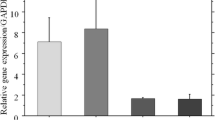Abstract
The effect of β-alanyl-L-histidinato zinc (AHZ) on protein components in osteoblastic MC3T3-E1 cells was investigated. Cells were cultured for 3 days at 37°C in CO2 incubator in plastic dishes containing α-modified minimum essential medium supplemented with 10% fetal bovine serum. After the cultures, the medium was exchanged for that containing 0.1% bovine serum albumin plus various concentrations of AHZ or other reagents, and the cells were cultured further 3 or 6 days. The homgenate of cells was analyzed with SDS-polyacrylamide gel electrophoresis (SDS-PAGE). The presence of AHZ (10−7 to 10−5 M) caused an appreciable increase of many protein components in cells. Especially, the 67 killo-dalton (kDa) and 44 kDa proteins which are the major components from control cells were clearly increased by the presence of AHZ. Furthermore, the concentrations of osteocalcin, insulin-like growth factor-I and transforming growth factor-β in the culture medium secreted from osteoblastic cells were markedly increased by the presence of AHZ (10−6 and 10−5 M). The effect of AHZ was a greater than that of zinc sulfate (10−6 and 10−5 M). The present findings suggest that AHZ can increase many proteins which are involved in the stimulation of bone formation and cell proliferation in osteoblastic cells.
Similar content being viewed by others
References
Burch RE, Hahn HKJ, Sullivan JF: Newer aspects of the roles of zinc, manganese and copper in human nutrition. Clin Chim 21: 501–520, 1975
Hurley LS, Gowan J, Milhaud G: Calcium metabolism in manganese-deficient and zinc-deficient rats. Proc Soc Exp Biol Med 130: 856–860, 1969
Oner G, Bhaumick B, Bala EM: Effect of zinc deficiency on serum somatomedin levels and skeletal growth in young rats. Endocrinology 114: 1860–1863, 1984
Yamaguchi M, Yamaguchi R: Action of zinc on bone metabolism in rats. Increases in alkaline phosphatase actiity and DNA content. Biochem Pharmacol 35: 773–777, 1986
Yamaguchi M, Oishi H, Suketa Y: Stimulatory effect of zinc on bone formation in tissue culture. Biochem Pharmacol 36: 4007–4012, 1987
Yamaguchi M, Oishi H, Suketa Y: Zine stimulation of bone protein synthesis in tissue culture. Activation of aminoacyl-tRNA synthetase. Biochem Pharmacol 37: 4075–4080, 1988
Yamaguchi M, Ozaki K: A new zinc compound, β-alanyl-L-histidinato zinc, stimulates bone growth in weanling rats. Res Exp Med 190: 105–110, 1190
Yamaguchi M, Ozaki K: Effect of the new zinc compound beta-alanyl-L-histidinato zinc on bone metabolism in elderly rats. Pharmacology 41: 345–349, 1990
Yamaguchi M, Miwa H: Stimulatory effect of beta-alanyl-L-histidinato zinc on bone formation in tissue culture. Pharmacology 42: 230–240, 1991
Yamaguchi M, Ohtaki J: Effect of beta-alanyl-L-histidinato zinc on osteo-blasic MC3T3-El cells: Increases in alkaline phosphatase and proliferation. Pharmacology 43: 225–232, 1991
Hashizume M, Yamaguchi M: Stimulatory effect of β-alanyl-L-histidinato zinc on cell proliferation is dependent on protein synthesis in osteoblastic MC3T3-El cells. Mol Cell Biochem 112: 59–64, 1993
Hasizume M, Yamaguch M: Effect of β-alanyl-L-histidinato zinc on differentiation of osteoblastic MC3T3-El cells: Increases in alkaline phosphatase activity and protein concentration. Mol Cell Biochem 131: 19–24
Kodama H, Amagai Y, Sudo H, Kasai S, Yamamoto S: Establishment of a clonal osteogenic cell line from newborn mouse calvaria. Jap J Oral Biol 23: 899–901, 1982
Sudo H, Kodama H, Amagai Y, Yamamoto S, Kasai S:In vitro differentiation and calcification in a new clonal osteogenic cell line derived from newborn mouse calvaria. J Cell Biol 96: 191–198, 1988
Lowry OH, Rosebrough NJ, Farr AL, Randall RJ: Protein measurement with the Folin phenol reagent. J Biol Chem 193: 265–275, 1951
Laemmli UK: Cleavage of structural proteins during the assembly of the head of bacteriophage T4. Nature 227: 680–685, 1970
Ceriotti G: Determination of nucleic acids in animal tissues. J Biol Chem 214: 39–77, 1955
Hauschka PV, Lian JB, Gallop PM: Direct identification of the calciumbinding amino acid gamma-carboxyglutamate in mineralized tissue. Proc Natl Acad Sci USA 72: 3925–3929, 1975
Nagata T, Todescan R, Goldberg HA, Zhang Q, Sodek J: Sulphation of secretedphosphoprotein I (SPP-I, osteopontin) is associated with mineralized tissue formation. Biochem Biophys Res Commun 165: 234–240, 1989
Nagata T, Goldberg HA, Zhang Q, domenicucci C, Sodek J: Biosynthesis of bone protein by fetal porcine calvariain vitro. Rapid association of sulfated sialoproteins (secreted phosphoprotein-I and bone sialoprotein) and chondroitin sulphate proteoglyncan (CS-PG III) with bone mineral. Matrix 11: 86–100, 1991
Hauschka PV, Lian JB, Gallop PM: Direct identification of the calcium-binding amino acid gamma-carboxyglutamate in mineralized tissue. Pro Natl Acad Sci USA 72: 3925–3929, 1975
Bronckers ALJJ, Gay S, DiMuzio MT, Butler WT: Immunolocalization of gamma-carboxyglutamic acid containing proteins in developing rat bones. Collagen Rel Res 5: 273–281, 1985
Centrella M, McCarthy TL, Canalis E: Transforming growth factor beta is a bifunctional regulation of replication and collagen synthesis in osteoblastenriched cell cultures from fetal rate bone. J Biol Chem 262: 2869–2874, 1987
Noda M, Yoon K, Prince CW, Butler WT, Rodan GA: Transcripitonal regulation of osteopontin production in rat ostosarcoma cells by type b transforming growth factor. J Biol Chem 263: 13916–13920, 1988
Noda M, Camilliere JJ:In vivo stimulation of bone formation by transforming growth factor-β. Endocrinology 124: 2991–2994, 1989
Hock JM, Centrella M, Canalis E: Insulin-like growth factor I has independent effects on bone matrix formation and cell replication. Endocrinology 122: 254–260, 1988
McCarthy TL, Centrella M, Canalis E: Regulatory effects of insulin-like growth factors I and II on bone collagen synthesis in rat calvarial cutures. Endocrinology 124: 301–309, 1989
Centrella M, McCarthy TL, Canalis E: Receptors for insulin-like growth factors-I and-II in osteoblast-enriched cultures from fetal rat bone. Endocrinology 126: 39–44, 1990
Yamaguchi M, Kishi S: Prolonged administration of β-alanyl-L-histidinato zinc prevents bone loss in ovariectomized rats. Japan J Pharmacol 63: 203–207, 1993
Author information
Authors and Affiliations
Rights and permissions
About this article
Cite this article
Yamaguchi, M., Hashizume, M. Effect of β-alanyl-L-histidinato zinc on protein components in osteoblastic MC3T3-El cells: Increase in osteocalcin, insulin-like growth factor-I and transforming growth factor-β. Mol Cell Biochem 136, 163–169 (1994). https://doi.org/10.1007/BF00926077
Received:
Accepted:
Issue Date:
DOI: https://doi.org/10.1007/BF00926077




